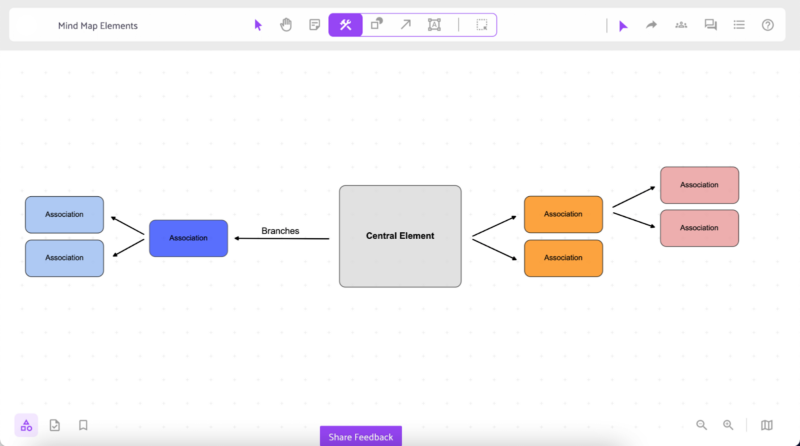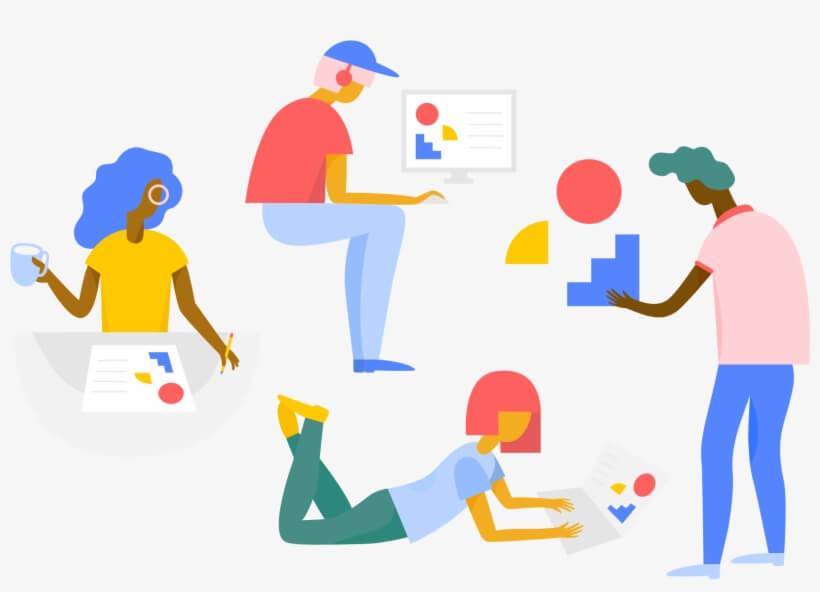Mind maps are some of the easiest diagrams to implement and use, but if you haven’t used them before you might have some questions about their definition and how they’re applied. In this article, we’ll highlight some of the most common mind map questions and provide a comprehensive answer for each.
Here’s a quick list of the 7 mind map questions that we’ll cover:
What 3 things are essential to mind mapping?
It’s extremely common when initially learning about a new diagram to ask what are the barebones essentials to make it work. For mind maps, these essentials are the central idea, associations, and branches.
The central idea is the key piece of information that outlines where your map is headed. This can be a problem, a topic, or a set of information you’re trying to memorize. Based on the goals of your map, this element will be the larger context of everything that follows and will relate even to the smallest details.
The associations are the nodes that relate to the central element and will expand outward with an increasing amount of detail. These will all be directed towards the end goal of your mind map, and they will all relate back to the central element in some way. They are usually brief, being only one or two words, and their vague nature allows room for interpretation and increased creativity.
The branches are the legs that connect the central idea with the associations and the associations to one another. The branches are critical to the structure of the mind map and make it incredibly easy to add ideas and expand your map.
These three elements are the foundation of mind mapping and with them, you can create a unique mind map that helps push you towards your goals.
What Can You Do With a Mind Map?
Second on the list of mind map questions is what is actually possible through mind mapping. Mind maps have a ton of different applications and here are some great examples of how to use them.
Brainstorming
Conducting a brainstorming session is one of the foundational ways of using mind maps and lets you ideate in multiple different directions without losing focus on the main goal. Mind maps are also especially helpful for brainstorming because they let multiple people collaborate on the same board while avoiding creative intersections.
Teaching
Mind maps are so effective because they diagram information in a way that’s easily accessible to people. This means that mind maps are really good at teaching and increase your ability to memorize and retain information.
The brain works better when information is displayed in a visual format, and this applies directly to mind maps. Mind maps create inherent visual connections between elements which allows you to easily follow them in any direction while remaining focused on the overall goal. This is super handy for learning and is a reason mind maps are well utilized for teaching.
Breaking Down Complex Concepts
Similar to the last point, mind maps are effective because they allow you to diagram ideas that are hard to convey otherwise. This often looks like concepts that entail a large string of relationships that can be hard to track and organize.
Mind maps give you a dynamic, sequential structure that lets you break down ideas in an easy-to-understand format. When entire concepts are presented like this, even if they’re quite complex, they become much easier to understand because you can see the connection between elements right in front of you. You don’t need to have a nuanced understanding of their connection before learning it because the connection is diagrammed for you.
While these aren’t the only applications of mind mapping, they are certainly the most common and the most effective. Now let’s move onto the third of our mind map questions where we address the purpose of these diagrams.

What Is The Purpose of a Mind Map?
Mind maps are diagrams that are widely applicable, so there isn’t one concrete purpose. Across their various applications, however, there are some common purposes that they serve.
Among many, their overall purpose is to create a structure for your ideas that is easy to navigate, visually pleasing, and contextually significant. They allow you to break down complex ideas into understandable branches of information, which also helps you learn quicker and more efficiently.
Essentials, the purpose of a mind map relates directly to the goals of the person using it, and in any scenario will help visualize information and break down complex relationships.
What Are The Benefits of Mind Mapping?
Mind mapping has a ton of different benefits for the user and in our article about mind map advantages, we outline 8 unique benefits. Here are the three most important benefits of mind mapping.
Improves Creative Output
Mind maps offer more perspective than other visual diagrams and because of this, they allow you to find more creative solutions to the problem at hand. Visualizing relationships and mentally referring back to your main goal often is a bit of added perspective that is really helpful when looking for creative solutions.
Breaks Down Complex Relationships
The organization created by mind maps lets you diagram relationships easily and visually demonstrate the connections between ideas. This makes understanding complex relationships much easier and lets you plan them out on a board.
Increases Retention
Mind maps are perfect for learning because they map out information in a way that’s easily understandable for the human brain. This structure means you can learn and retain information quicker and easier.
Can Mind Maps Be Drawn by Hand?
Of course! Mind maps can always be drawn by hand but they’re most often used through online whiteboards. Creating mind maps online means the template is much more dynamic, allowing you to move associations across the map and add elements anywhere. While mind maps can be drawn on a traditional whiteboard, they’re best utilized online where they gain a level of dynamism.
Are Mind Maps Helpful for Troubleshooting?
Mind maps are extremely helpful for troubleshooting and one of the most important examples of their application is for problem-solving.
During troubleshooting, you put the problem as the central idea and each of your possible solutions becomes its own branch. This gives you some context as to how the various solutions come to life and how they relate to the main problem.
Additionally, you can ideate multiple different paths forward and determine which would be the most effective after you create many different viable solutions. Different personas might view different solutions differently so it’s important to branch out in multiple different directions to include a wide variety of solutions.
Are Mind Maps and Flow Charts the Same Thing?
Not exactly. Flow charts are very linear, starting from one statement and moving forward in one direction. They are most commonly used to map out a given experience or journey and are not usually used for brainstorming or problem-solving.
Mind maps, on the other hand, are non-linear and branch out in different directions to create multiple different trains of thought. They incorporate many different ways to ideate and allow you to explore multiple different ideas at once.
Learn more: What Is a Mind Map?
Conclusion
Hopefully, this list of mind map questions helped improve your knowledge and ability to create and utilize mind mapping. If you enjoyed this, check out some of our other guides like how to create your own mind map.
Most Recent Posts
Explore the latest innovation insights and trends with our recent blog posts.













